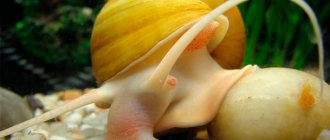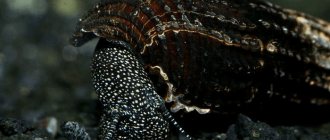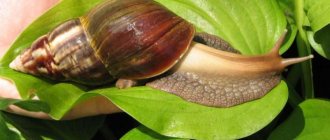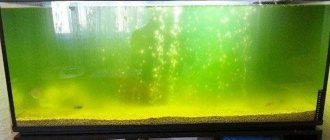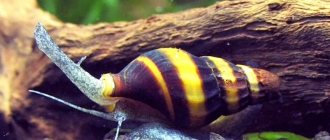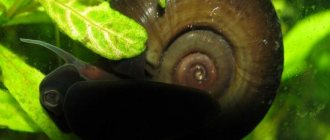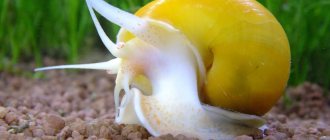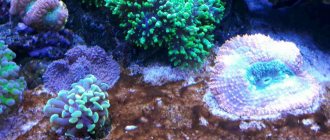The average lifespan in an aquarium or terrarium is 5-10 years
The snail is a mollusk of the gastropod family, found throughout the world, with the exception of Antarctica, North America and the cold regions of Eurasia. All individuals are divided into three main categories (land, aquatic and pulmonary), each of which combines dozens of subspecies. In the wild, mollusks live in large, dense colonies.
Gastropods live in seas and oceans, coastal areas of lakes, rivers and ponds, wetlands and damp places. Snails are popular among aquarists as pets. Graceful, slow-moving mollusks are chosen for their beauty, extraordinary intelligence and intelligence, and their ability to calm and relax.
Naturally, future owners are interested in how long snails live at home? Surprisingly, pets live much longer in captivity than in their natural habitat, where they have many enemies. The average life cycle of gastropods in an aquarium (terrarium) varies from 5 to 10 years. But there are also record-breaking long-livers, living up to 20-25 years. What determines the lifespan of a mollusk? We'll find out now.
Keeping the Achatina snail (Terrarium)
So, the main factor with which the lifespan of Achatina in captivity is associated is the conditions created for them by man.
Let's look at what it takes to keep your pet happy. The volume per 1 snail should not be less than 10 liters. For example, if you keep a couple of pets, you should at least purchase a 20-liter terrarium. You can buy a factory-made container or try to make it yourself, it doesn’t really matter. You definitely need a lid on the container. Achatina are inquisitive creatures and, if there is no lid, they can crawl out. And this is fraught with injury or even death of the animal.
The necessary maintenance condition is loose and soft soil - such that the mollusks can completely bury themselves in it. The soil layer is 50-100 mm. Under no circumstances should you use soil sold in a specialty store for growing house plants. It may contain chemical compounds harmful to Achatina.
In the same flower shop (or pet supply store) you can buy coconut substrate, which is sold in briquettes. Before placing it in the terrarium, scald it with boiling water and wait until it cools down. Then rinse by placing in a sieve or gauze. High-moor peat can be used as soil for snails. Pebbles and sawdust are absolutely not suitable as soil, since there is a risk of damaging the rather fragile shell or delicate body of the mollusk.
You can conclude that hydration is necessary if you carefully monitor the behavior of the snail. If the soil is moist, the pet happily moves along it and buries itself inside. When overwatered, the snail sits on the wall of the terrarium for a long time. If the soil is excessively dry, the animal hides in the shell and closes with a lid.
Achatina are heat-loving people, so the optimal temperature for them is quite tropical - from 25 to 28 degrees. If the temperature is too low or high, the animal goes into hibernation, this of course affects how long Achatina snails live at home. As an additional source of light and heat, you can use a regular incandescent lamp. There is no need to purchase complex special equipment.
This is a prerequisite for the well-being of pets. At least once a week it is necessary to clean the terrarium of snail waste products and food debris. The glass should be wiped with a slightly damp cloth or sponge, without using detergents. It is necessary to change the soil and do a general cleaning of the snails’ home once a year.
In order for your pet to feel as comfortable as possible in your house or apartment, take care of the ideal home for it.
Choosing a house
Use a container, aquarium or terrarium.
One medium-sized snail feels comfortable in a 10-liter container. The larger the pet becomes, the larger the house will have to be purchased for it.
The closer the conditions inside the home resemble those that exist in the wild, the more comfortable the snail will feel.
The top of the container must be protected with a lid. To allow fresh air to enter the house, move the lid a little or arrange small openings. You can place moss, fragments of clay pots, and poorly rotting wood at the bottom. It wouldn't hurt to plant ferns or ivy. This will make your home more comfortable and beautiful. And live plants will purify the air in the aquarium.
It is not recommended to use sand or peat as a substrate (filler). The walls will be constantly dirty, and sand also encourages individuals to lay eggs, the disadvantages of which we have already written about.
In any case, it is necessary to clean the room as it gets dirty. Typically this will be required once a month or every few months. We are talking about cleaning glass and changing the substrate. It is advisable to remove your pet’s waste products daily. This will not take much time, but will ensure the cleanliness of the snail’s home, and therefore yours.
Because of its cleaning abilities, the ampularia has gained immense popularity among aquatic life enthusiasts. The snail destroys plaque on the walls of its home, rids the aquatic environment of waste products of other aquatic inhabitants, and also gets along well with various types of aquarium fish.
Proper care of the mollusk has a huge impact on how long the ampullaria snail lives, which has a huge impact on the snail’s lifespan.
By creating the correct temperature regime, namely 23 - 25 degrees, the ampoule can live in an aquarium for at least three years.
At a temperature of the aquatic environment of 25 degrees, the lifespan of the snail will be reduced to one year, since all the life processes of the mollusk will occur much faster due to the too warm temperature regime.
Temperatures below 23 degrees can increase the lifespan of ampoule up to four years.
Some sources indicate the fact that if you feed the ampularia snail with specialized food, its life expectancy will be significantly longer and its lifestyle will be more active.
The Physa snail is native to North America and Asia. They do not have a distinctive appearance, and are not as remarkable as many of their relatives. The size of the physeal is only 2 cm.
Physa is not typically introduced into the home aquarium on purpose; in most cases, its colonization occurs randomly. The snail is characterized by rapid reproduction, so removing it can sometimes be problematic, even considering the fact that these snails are an excellent treat for most types of aquarium fish.
The most remarkable feature of the snail is its ability to leave a trail of mucus along which the snail moves from the bottom to the surface of the aquarium. In home conditions, physes live for 11-14 months.
Reels prefer fresh water. In home aquatic aquariums, in most cases, you can find snails with red and brown colors. The mollusks have a distinctive appearance, so most breeders purchase these snails to create a more natural environment in their home aquarium.
A fascinating ability of snails is the ability to move across the water surface. Their lifespan is 2-4 years, but during their lives they produce several generations of new individuals.
In the natural nature of melania, it is typical to live in freshwater environments in Asia, Australia, and Africa.
They can get into a home aquarium by accident, since they are not very noticeable aquatic inhabitants.
It has a yellowish or dark gray color and a size of about 3-4 cm. Their distinctive aspects are:
- ability to breathe through gills;
- lead an active lifestyle in the dark;
- the opportunity to give birth to offspring.
Melania delights its owners for 2.5 to 3.5 years.
To accurately answer the question of how long aquarium snails live, you need to decide on the type of home mollusk, and also do not forget that the lifespan is directly dependent on the correct care and maintenance of snails in a home aquarium.
Most varieties of the Achatina snail are unpretentious; they do not require special care or maintenance at home. They do not need special buildings for themselves; the snail can be kept either in an aquarium without water or in a specially purchased house. The most appropriate decor for decorating the interior space will be plants, since in addition to an attractive appearance, vegetation will help saturate the space with oxygen. Snails will also be able to feed on them, making their diet more varied.
We suggest you read: How to teach a puppy not to be afraid to walk outside without conflicts and resentments
How the owner cares for his snail and what conditions he creates will directly determine the life expectancy of the pet.
The more individuals live together, the more space there should be for each Achatina; keeping 4 individuals requires an aquarium of at least 20 liters. In this article we will consider in detail all the requirements for a habitat for Achatina.
Place to live
A snail's house should be comfortable and safe. As a habitat, you can use an aquarium left after the fish, a plexiglass or plastic terrarium, a container made of transparent plastic is also suitable, for the Achatina snail the main condition is air and space. For a medium-sized individual, a container of at least 3 liters is required.
Aquarium for Achatina
For the comfort of Achatina’s life, it is necessary to sprinkle soil at the bottom of its home. The substrate is very important, since they can rummage and burrow in such litter; this behavior is especially often observed in snails during the daytime. The best option is a combination of coarse sand of loose consistency with non-acidic soil.
It is not advisable to use peat, since its environment is acidic. It is best to use coconut or orchid substrate, but if this is not available, then any flower substrate will be suitable for Achatina. You can add hazelnut shells and walnut cores. It is strictly forbidden to use clay and fatty loams, pieces of bark and wood as soil.
How thick the mound will be depends on the age of the snails; for young snails, soil up to 3 centimeters is needed, for adults - a maximum of 7. The soil for a snail should always be moist, so it is important to monitor this regularly. If there is not enough moisture for the pet, then Achatina will wet it with its own mucus, as a result of which it will get dirty on the substrate and leave a mark on the surface of the container or aquarium.
For Achatina snails, it is extremely important what substrate is used as bedding, since in a favorable habitat, they begin to lead a more active lifestyle and reproduce faster.
Conditions
Characteristics of the main features for keeping Achatina at home:
- Temperature regime (the temperature for keeping a pet at home should vary from 20 to 28 degrees Celsius)
- Moderate humidity (with high air humidity, Achatina begins to climb up the walls, and if the air is too dry, they bury themselves in the ground).
- No direct sunlight
Coil
The most common variety of freshwater armored fish, which has long been kept in the aquarium. Its shell is flat and twisted in a spiral. The diameter of the shell of large individuals does not exceed 3.5 cm, and the thickness is rarely more than 1 cm. Its color is red or brown. Coils easily tolerate strong temperature fluctuations and can live and reproduce both in a warm tropical aquarium and in a cold one with fish from Russian rivers .
Their value for the aquarium is that they eat the film formed by bacteria on the rotting leaves of aquatic plants. They do not eat healthy green leaves. The proliferation of coils is so fast that their number must be constantly controlled, getting rid of unnecessary ones. How many snails should be in the aquarium is determined by its size. Start 1 coil for 5 liters of water.
Lifespan of ampullaria in a home aquarium
Oddly enough, this mollusk is a vivid example of the fact that in captivity it sometimes lives better than in natural conditions. Domestic snails live quietly for 5, and sometimes as long as 10 years. How long Achatina snails live at home is directly related to the quality of their habitat.
As for wild individuals, they were much less lucky. In nature, mollusks have many enemies, and humans are the main one of them. Achatina are considered pests that destroy cultivated plants, so they are exterminated mercilessly.
In order for your pet to be healthy and live a long time, proper and sufficiently varied nutrition is necessary. Here is a list of products that must be included in the Achatina diet.
- Hard boiled egg.
- Corn.
- Fresh fruits and vegetables.
- Peas.
- Mushrooms.
Products must be alternated so that the animal gets used to a varied diet. The source of calcium for Achatina is crushed egg shells and ordinary chalk. It wouldn’t hurt to purchase a mineral and vitamin mixture for snails at a pet store. If a mixture for reptiles is sold, buy it, it is also suitable for Achatina.
As you can see, Achatina are by no means primitive, but very interesting animals that bring many pleasant moments to their owners. What is it worth to bathe in warm water from the hands of the owner! Snails simply love this procedure. Before purchasing a pet, study all the nuances of the animal’s behavior and care features.
Achatina typically lives not in aquariums, but in aquaterrariums. However, Achatina also quite often act as a pet. The most valuable qualities for them are their large size, as well as the use of this type of mollusk in cosmetology. Some argue that Achatina typically has a positive effect on the state of the human nervous system.
The lifespan of Achatina is influenced by factors such as:
- The volume of the aquaterrarium must be selected in accordance with the size of the pet.
- Temperature, humidity and soil.
- Proper and balanced diet.
Choosing a house
The average lifespan of a snail can last from 12 months to 4 years, and there are only a few species that live more than 10 years. It can be argued that the artificial environment has a bad effect on the lifespan of mollusks, however, there are several factors, the presence or absence of which affects the increase in the lifespan of a snail.
- Water temperature in the aquarium. The normal temperature at which existence is possible must be at least 23 degrees Celsius, but not more than 27 degrees. An environment that is too cold or hot has a negative impact on snails, wearing out their body.
- Hardness of water. The water in the aquarium must have a hardness of at least 8 units, but not more than 15 units. The great softness of the water eventually destroys the calcareous coating of the mollusks.
- Acidity of water. Normal water acidity is about 7 or 8 units. Too much difference in water from these values can even kill the snails.
- Nutrition. To live normally, snails need calcium, which forms their shells. It is imperative to include fresh vegetables in the snail menu, as well as vitamins, which can be purchased in special stores.
- Relationships with other inhabitants of the aquarium. Of course, animals that eat snails should not be placed with the snails themselves. This will not only jeopardize the snails' habitat in the aquarium, but will also negatively affect other individuals who are lucky enough to escape a sad fate.
- Relationships with other snails. Loneliness has a pretty bad effect on these clams. It is best to get several snails at once. They need communication with their own kind.
- Conditions inside the aquarium. Clean water, a high level of soil aeration, and regular water filtration have a positive effect on the overall well-being of snails, as well as on most underwater living creatures.
- Communication with a person. In general, communication with humans does not cause significant damage to snails, however, it is necessary to adhere to some rules. You should not pick up a snail by its shell, and under no circumstances should you allow the mollusk to fall. Most often, snails themselves climb onto a person’s palm; it will be enough to simply substitute it.
The temperature and humidity required by Achatina are approximately the same as those in an ordinary city apartment. Soil moisture is determined empirically. If the snails sit on the walls of the terrarium all the time, it means there is too much water. If they prefer to be sealed (the evidence is hidden in the sink and closed with a lid), on the contrary, it is too dry.
To awaken a clogged snail, you can pour water over its mouth and carefully remove the cap, or simply place it in a terrarium with normal humidity. It is recommended to wash the terrarium at least once a week. The exception is a terrarium with a clutch of eggs, which must be cleaned without water so as not to change the humidity and not damage the clutch.
We invite you to familiarize yourself with: First mating of a Thai cat
It is better to keep small snails without soil, covering them with cabbage or lettuce leaves, thereby increasing the chance of the snail finding food and making it easier to care for the terrarium.
It is better to feed as food is eaten and dried and remove any leftovers. Achatina eats vegetables, fruits and herbs, but in nature they do not refuse meat. Usually in captivity they are fed cabbage, carrots and cucumbers, but it is preferable to give them a more varied diet. This is necessary first of all so that at any moment you can switch to another available type of food.
It is known that snails have certain food preferences, including many who prefer cucumbers and lettuce to other foods and, if they are fed only cucumbers from childhood, they often refuse to eat anything other than them, which can cause some inconvenience. Large snails can be given whole cores; they process food waste surprisingly quickly.
Soft foods should be given only for a short period of time, otherwise they will flow and spread across the soil, causing it to become contaminated. It is generally not recommended to give soft foods to small snails. There was a case when snails buried themselves entirely in a banana and suffocated there. It is better to give very small newborn snails greens, grated carrots, and after a few days lettuce and an apple.
Fruits: apple, apricots, pineapple, avocado, bananas, pear, wild strawberry, strawberry, cherry, mango, papaya, plums, bunch of grapes, figs, watermelon, melon.
Vegetables: pumpkin, rutabaga, zucchini, broccoli, champignons, lettuce, cucumber, potatoes (boiled), carotel carrots, red peppers, celery, spinach, tomato, cabbage leaves.
Beans, peas (cooked or fresh), oatmeal.
Other: mushrooms, meadow plants/trees, nettles, daisy flowers, elder flowers, clover, dandelion, plantain, yarrow, sprouted oats, alfalfa, fruit tree blossoms (apple, apricot, peach...), bread (softened), milk (powdered) or natural), dairy/lactic acid products (without sugar, salt, spices), minced meat (minced meat, raw or boiled meat), egg (boiled), compound feed, meat and bone meal, peanuts (chopped), vegetable and meat baby food, gammarus.
It is important that the plants are not picked within the city, factories or enterprises, wastewater, or landfills. After you bring it home, rinse thoroughly in warm water!
Spicy, salty, sour, sweet, smoked, fried, pasta, potato eyes.
Achatina snails are hermaphrodites, that is, each individual has both male and female genital organs. In the absence of a partner, self-fertilization is possible, but it is quite rare.
The snail can store sperm for two years after mating, using it to fertilize maturing eggs. The number of eggs in a clutch is about 200 (in some cases up to 500); the snail can lay 5-6 clutches annually. The size of one egg is 4.5-5.5 mm, its shape resembles that of a chicken. Egg development is possible at temperatures from 22°C and lasts from several hours to 17 days.
The main food for Achatina snails is plant food. Food for Achatina in the home environment should be varied. Mollusks eat a lot, so the list of what you can feed Achatina gastropods is wide. Most of all they love apples, fresh cucumbers, and lettuce, but Achatina’s diet should not be limited to these foods.
Juveniles should be fed once a day. Feeding older Achatina snails should occur no more than 2 times a week. She eats mainly in the evening, since snails are nocturnal. Summer food does not differ from the winter diet, but in summer they can be fed with seasonal berries and fruits.
The main list of what to feed snails:
- tomatoes;
- legumes;
- mushrooms;
- boiled eggs;
- spinach;
- zucchini;
- boiled potatoes;
- sour cream.
If it has a calcium deficiency, the snail can feed on pieces of the shell, attacking its relatives. In such a situation, you need to add to the snail’s diet: sepia, crushed shell rock, shrimp called daphnia, and gammarus crustaceans. There should always be fresh water in the container. After eating, the remaining food must be removed so that it does not cause discomfort for Achatina.
Effect of calcium on shellfish
Snails need calcium to build their shells. Calcium is a very common chemical element.
Lack of calcium in the snail's diet leads to curvature and deformation of the shell. The snail shell becomes softer due to lack of calcium; it is not protected from the environment. Since all internal organs are attached to the walls of the shell, any damage to it can lead to improper functioning of the organs or death.
In order to prove how important calcium is for snails, I conducted an experiment.
Two groups of snails of the same age and species were taken and placed in the same conditions, but they were fed differently: some with food with added calcium, others with its complete absence.
Soon the snails of the second group stopped growing. It follows from this that calcium is indispensable for mollusks.
Snails kept in captivity receive calcium from sepia, eggshells, feed chalk, shell rock, gammarus, etc. For a more effective result, calcekashes are made. Calcekasha is a nutritious mixture made from various cereals with the addition of various sources of calcium; This product is served both dry and boiled.
How long do representatives of different species live?
About 100 thousand different species of snails live on Earth. Here we will consider only the main ones that people have kept in artificial reservoirs for centuries, and the care of which is relatively simple.
Water
- Tiger snail/neretina. The average lifespan of such mollusks in an aquarium is about 4 years. They prefer to live in hard water. It got its name due to its peculiar color. It feeds on algae and does not require special care. When living at home, it can crawl outside the aquarium tank, which shortens its life, since this is fatal for it.
- Coil. These small snails are typical inhabitants of the aquariums of avid professionals. They live for about 3 years, sometimes they can live 4 years. They reproduce actively and frequently. They can swim upside down on the surface of the water.
- Ampularia. It has a bright, pleasant, yellow color. It is a relatively peaceful inhabitant of the aquarium and is mainly engaged in cleaning the aquarium from waste. In captivity, unfortunately, it lives only about 2 years. In nature, in its homeland - the Amazon - it can last about 4 years.
- Fizy. They have an unusual brown-spotted color. Quite small, similar to coils. Due to their size, they often become additional food for some fish. Usually they are not introduced deliberately; more often they end up in the aquarium by accident. They cannot live long - their life expectancy is about 10 months.
- Melania. It has an unusual purple color and an elongated shell. It has a reputation as an aquarium parasite, as it reproduces actively and quickly. It can live up to 3 and a half years and does not require special care.
Land
- Achatina. A typical representative of a land snail species. These large snails should live in terrariums.
On average, they live for about 5 years, however, with good care they will live twice as long.
- Megas. They look completely ordinary - they have an inconspicuous cream or brown color. Compared to Achatina, they secrete much less mucus. They can live next to a person for almost 14 years.
- Arhahatina marginata ovum. This species represents snails in the classic sense of these mollusks in the minds of most people (exactly as they are depicted in children's books). They can have different colors - from beige to brown. The shell pattern can be stripes and dots. They have a large, twisted shell. In captivity they can live up to 10 years.
We invite you to read: How ancient people hunted mammoths.
Life in an ancient mine: how did our ancestors hunt mammoths? Weapons, tools and products of ancient man Other species are mainly represented by pulmonate snails. Their peculiarity is that they can live both on land and in water. In the aquatic environment, they prefer only fresh water bodies; with rare exceptions, they can live in fresh areas of salty seas.
- Thylomelania. Looks like melania. It usually has a yellow body and a dark, elongated shell 13 cm long. Under normal conditions, it lives from 5 to 7 years.
- Brothia Pagoda. It is a small mollusk with a twisted shell on which spines are formed. It has a spotted body and a yellow-brown-black shell.
- Maryse. A small mollusk, the height of an adult is about 5 cm, the width is about 2. It can live from 2 to 4 years. The shell is twisted into a regular funnel. Externally similar to a reel.
- Pokemon. Another name for the snail is tropical pond snail. It is distinguished by a fragile, almost transparent shell covered with sparkles. Can be beige, yellow and green. It is small in size and lives only about a year.
Melania
Is viviparous. The length of the mollusk shell is 3.5 cm. Its shape is a narrow cone, and its color ranges from light yellow-green to dark gray with clear purple strokes. The body is silver or lilac. The snail breathes through the gills, and a significant amount of oxygen is vital for it.
Melania soil cleaners. They mix the substrate, which improves gas exchange in the container and prevents the process of decay of organic matter trapped in the deep layer. Mollusks reproduce quickly, and to prevent unwanted population growth, excess mollusks are caught or added to the pond. Melania will only benefit a small number of individuals.
Lifespan of a tiger snail
In addition to implementing the factors described above, you need to remember that it is necessary to stock mollusks in aquariums or terrariums of a suitable size. For example, in order for one Achatina to feel comfortable, you need to purchase a terrarium of at least 10 liters.
Also an important component of snail life is high quality soil. It must be at least 3 cm thick so that the snail can burrow into it. Without these factors, your pet's life can be significantly shortened. Of course, compliance with all conditions will be useless if you do not monitor the health of the snails and do not promptly recognize and treat diseases.
In general, it can be noted that one should not expect a long existence from a snail, characteristic of most mammals. However, if you wish and follow certain rules, the life of a mollusk can be extended almost twice.
For information on how long Achatina lives and how to care for them, see below.
The tiger snail is native to South Africa. The mollusk got such an interesting name because of its shell, which has a light brown tint, on which there are dark stripes.
Snails prefer hard water. They may well escape, so a lid in a home aquarium is a must. Representatives of tiger snails live for about 3-4 years.
Advantages and disadvantages
To understand whether mollusks are needed in an aquarium, get acquainted with the positive and negative aspects associated with such inhabitants. The benefits of their presence in the aquarium are as follows:
- maintaining cleanliness - snails in the aquarium eat leftover food and algae on soil stones and glass. They are natural orderlies and eat dead fish if the owner does not remove them while away;
- monitoring the condition of the water - shellfish behavior shows that there is a problem with the reservoir. Thus, Melania float to the surface with low oxygen levels. This role of snails in the aquarium allows you to eliminate the problem before it threatens the fish;
- A bright decoration for an aquarium - large mollusks have an elegant shell. Aquarists often keep several species with different colors and shapes of shells at the same time.
Shellfish are harmful due to the following:
- eating plants if there are no algae on the walls;
- copious secretion of mucus - characteristic of some species;
- excess due to reproduction.
To ensure that the disadvantages do not outweigh the advantages, you must carefully select the type of shelled inhabitants and control their number by removing young individuals that are handed over to a pet store. Understanding why snails are needed in an aquarium, it is difficult to make a mistake when choosing them.
Description
Achatina belongs to the mollusk family. Before animals were domesticated, snails lived exclusively in the tropics and subtropics of the earth. Therefore, an artificially created habitat is extremely important for its life.
The body of the mollusk is soft and tuberous, and the shell can be up to 30 cm in length. The color varies:
- black-brown;
- swamp;
- brown;
- brown with dark stripes.
In nature, there are also exotic animals called albinos, whose shell is white in color and smaller in size than that of ordinary representatives.
Achatina are hermaphrodites and very prolific; at one time the mollusk can lay from 100 to 600 eggs. Let's look at a more detailed description of the types of snails and the conditions for keeping them.
Types of Achatina
There are about 60 species of African snails. Each is unique and different from the other.
Does not require regular maintenance. Fulika eats a lot, is not picky in choosing food, loves water, but does not tolerate too high humidity. Moves slowly and monotonously. If you scare her, she hides in a shell, squeaking. She is friendly with her relatives.
The reticulata is mobile, loves contact, and is curious, so it always stretches its head forward. She eats everything, is well trained, so she can be taught to eat on time. He does not sleep in the first half of the day and leads an active life. Remembers and recognizes the owner.
It is often kept for a home terrarium. It grows slowly, so it reaches a size of no more than 15 cm.
It grows quickly, so at 6 months it already reaches 12 centimeters. He sleeps during the day and leads an active life at night. Friendly and sociable.
Albopicta Fulica Reticulata Immaculata
Lemon Achatina is viviparous and does not lay eggs. Active and sociable. Loves delicious food. Distinguishes the owner from others and loves to sit on the palm. Leads mainly nocturnal life, crawls, eats, makes sounds.
The body is massive. Grows quickly with quality care. Loves to swim.
They often go into hibernation. They can gnaw on the shell of another snail living nearby. They are rarely kept as a pet, as they require complex care and conditions.
- "Tiger" or common Achatina.
Common Achatina are the largest representatives. Calm individuals are characterized by laziness, so they often sit in one place, leaving it only to eat.
Lemon Achatina Brown Achatina Zanzibarica Achatina Tiger
Snail dimensions
The size of Achatina snails, regardless of the species, is approximately the same. The average size reaches 12–15 centimeters. Scientists, observing how snails grew at home, discovered that the difference in size between individuals reaches both several millimeters and tens of centimeters, while the individual factor is not excluded; there are the most active and voracious mollusks, which grow due to a certain lifestyle relatively quickly.
Living in natural conditions, Fulica reaches a larger size; such snails grow up to 20 cm, and when in a terrarium, the length of Achatina will be no more than 17 cm.
Reticulata, regardless of environmental conditions, grows up to 18 cm. Albinos grow longer, therefore they are smaller in size than their relatives and reach no more than 15 cm. Albopicta grows quickly, in comparison with other Achatina, so in six months it will look larger than any other species.
It is important to know that with poor care, mollusks grow more slowly and reach smaller sizes. By creating the ideal conditions necessary for a particular variety, you can grow Achatina of impressive size, up to 25 centimeters.
Achatina size
A snail grows throughout its life. After two years, the growth rate of Achatina noticeably decreases. At one year the snail reaches puberty and is ready to have offspring. The lifespan of Achatina is usually 6–8 years. However, with good and proper care, some representatives lived for 10 years. If a mollusk lives in the wild, then the main danger that shortens its life span is other animals.
If Achatina lives at home, then the main reason for the shortening of life is cracks and chips of the shell. If this happens, then the first thing you need to do is to separate the snail from its relatives for a while, since they love to interact with each other, it is also important to treat the area of the crack and chip with a disinfectant. After taking the above measures, the mollusk can live as long as it should, regardless of the presence of damage to the shell.
Fiza
Due to the mucus that the fish secretes in large quantities, the aquarium is cleaned 2 times a week. The appearance of the mollusk is attractive. This pet has a rounded, elongated shell with a sharp apex. The color of the shell is brown or gray-brown with irregular speckles of golden color. The size of the snail is 2 cm.
Physa can not live without water for long. Its breathing is pulmonary, which is why the snail requires regular rise to the surface. With a lack of food, Physa is capable of eating even the toughest vegetation, which is too tough for large snails and fish. To prevent spoilage of greens, you need to know what to feed the snails in the aquarium.


